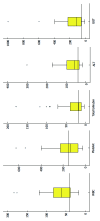Chronic liver disease is universal in children with biliary atresia living with native liver
- PMID: 29209118
- PMCID: PMC5703937
- DOI: 10.3748/wjg.v23.i43.7776
Chronic liver disease is universal in children with biliary atresia living with native liver
Abstract
Aim: To examine the medical status of children with biliary atresia (BA) surviving with native livers.
Methods: In this cross-sectional review, data collected included complications of chronic liver disease (CLD) (cholangitis in the preceding 12 mo, portal hypertension, variceal bleeding, fractures, hepatopulmonary syndrome, portopulmonary hypertension) and laboratory indices (white cell and platelet counts, total bilirubin, albumin, international normalized ratio, alanine aminotransferase, aspartate aminotransferase, γ-glutamyl transpeptidase). Ideal medical outcome was defined as absence of clinical evidence of CLD or abnormal laboratory indices.
Results: Fifty-two children [females = 32, 62%; median age 7.4 years, n = 35 (67%) older than 5 years] with BA (median age at surgery 60 d, range of 30 to 148 d) survived with native liver. Common complications of CLD noted were portal hypertension (40%, n = 21; 2 younger than 5 years), cholangitis (36%) and bleeding varices (25%, n = 13; 1 younger than 5 years). Fifteen (29%) had no clinical complications of CLD and three (6%) had normal laboratory indices. Ideal medical outcome was only seen in 1 patient (2%).
Conclusion: Clinical or laboratory evidence of CLD are present in 98% of children with BA living with native livers after hepatoportoenterostomy. Portal hypertension and variceal bleeding may be seen in children younger than 5 years of age, underscoring the importance of medical surveillance for complications of BA starting at a young age.
Keywords: Biliary atresia; Chronic liver disease; Medical status.
Conflict of interest statement
Conflict-of-interest statement: None of the authors has any potential conflict of interest to declare.
Figures


References
-
- Schreiber RA, Kleinman RE. Biliary atresia. J Pediatr Gastroenterol Nutr. 2002;35 Suppl 1:S11–S16. - PubMed
-
- Liu MB, Huong TB, Hoang X, Doan L, Trinh S, Anh Nguyen HP, Thanh Le H, Holterman AX. Biliary atresia in Vietnam: Management and the burden of disease. Surgery. 2017;161:533–537. - PubMed
-
- Utterson EC, Shepherd RW, Sokol RJ, Bucuvalas J, Magee JC, McDiarmid SV, Anand R; Split Research Group. Biliary atresia: clinical profiles, risk factors, and outcomes of 755 patients listed for liver transplantation. J Pediatr. 2005;147:180–185. - PubMed
-
- Shneider BL, Mazariegos GV. Biliary atresia: a transplant perspective. Liver Transpl. 2007;13:1482–1495. - PubMed
MeSH terms
LinkOut - more resources
Full Text Sources
Other Literature Sources
Medical

